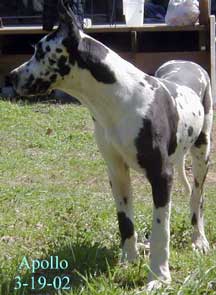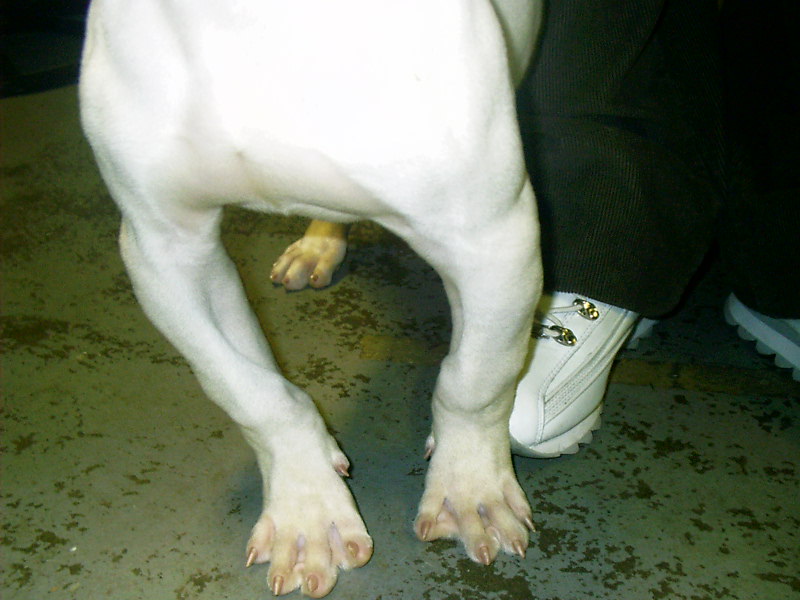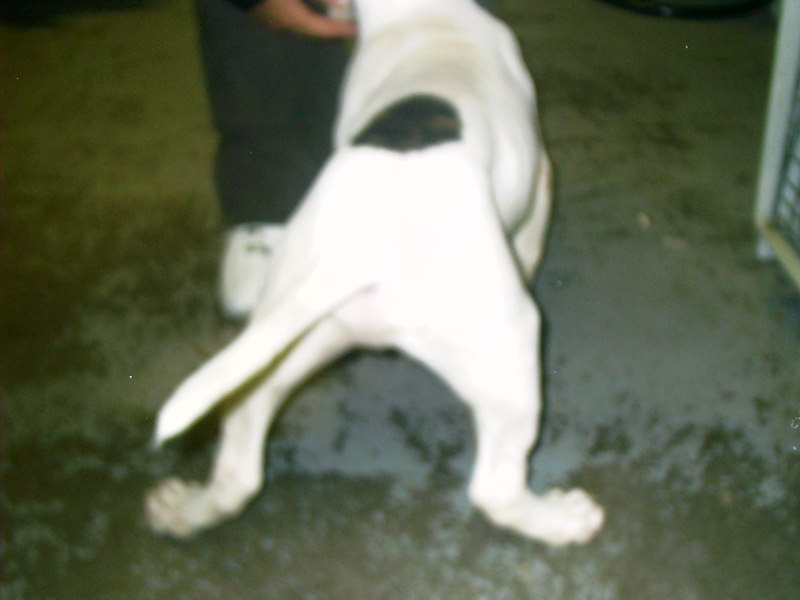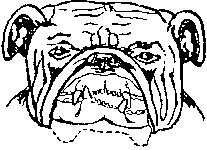Bulldog Information
![]()
 |
|
This information we have acquired is from people that own American Bulldogs. This information is not proven by a vet, and is only information that we thought may be useful to others. We decided to put this miscellaneous info. on our site for people so that it may be useful for health concerns or just general bulldog knowledge. We hope that this info. proves helpful to owners. If you would like to add info to our page feel free to e-mail us at bullyabs@yahoo.com Thank You, Cliff and Melissa Hammer HAMMERS AMERICAN BULLDOGS
|
|
What qualities do our dogs need?
Here at Hammer's American Bulldogs we are striving to produce a better bulldog by being selective in choosing our breeding stock. In order for a dog to qualify in our program it must possess many attributes to help better the fantastic breed. We have and will turn dogs away that do not fit the criteria needed for our program. Stable temperment: We are trying to produce a stable tempered dog that will be able to be for breeding as well as being the families beloved pet. Conformation: Dogs that are severely cowhocked, swayed backed, poorly angulated, or any other severe conformation flaws will not be accepted. Hips: All stock will be x-rayed either by OFA or Pennhip for breedable hips. No dog with signs of DJD ( Degenerative Joint Disease) will be used in our program. Overall function: A dog must be put together correctly to function well. We only accept dogs that will be able to excel in movement for work ability. The perfect American bulldog! As breeder's we know that producing the perfect dog is almost impossible. Dogs like any species have flaws. We are in this breed to try to produce a dog that will best suit the breed characteristics, and be a fine example for the breed. This is how we try to contribute to helping better the breed in our own little way. The ideal dog we are trying to produce as far as type is:- Males = 90-110 lbs. 24 in.- 25in.Tall Females = 75-95 lbs. 22in.-24in. Tall Moderate bully Conformationally correct Very functional |
|
Pet quality dogs "Why is my dog pet quality" We hear it all to often. You sell your bulldog puppy to a happy pet owner and a year later you hear about the litter of pups they just had. Never a good thing for us breeders to hear when we work so hard to insure that the pet pups we sell are indeed just pets. To many times pet owners will have many reasons why they think their dog should be bred. " He's the best dog I have ever owned I want one just like him", My kids want to see the miracle of birth", She would be happier if she had puppies she 's very motherly", "Puppies are fun!!", " My male needs to be a male, he's mouting everything" I got to say I think I have heard it all, but let me tell you why not to breed your pet dog. Why is it a pet? When us breeders sell a dog as pet quality we feel it is just that... Pet Quality. Most breeders will sell as pets due to minor structural or conformation flaws that most pet owners may not even notice. To breeders this makes them not breed worthy, and it is an important part of being a good breeder. Also when the dog is an adult and ready at the approx. age of 2 for breeding, tests need to be done to see if the dog is of quality. Just because your dog is pretty, or sweet does not mean it's breed worthy. Not all puppies are going to grow up to be breeding quality and it is our job as breeders to determine this. This is only one reason not to breed your pet. Let me tell you more.... Hip Dysplasia A fault of the American Bulldog that the pet owner might not see is Hip Dysplasia. This disease runs very high in this breed causing the dogs to be lame or to be in pain. This is a disease of the hips that breaks the hip bones down. In some cases if to bad the dog will have to be euthanized or the hips on the dog will have to be replaced. Last I heard it was $2500.00 a hip. Yikes! Your dog can run and jump 6 ft in the air and may have hip dysplasia. This is genetic and has a high chance of being passed to puppies even if the dog is bred to another dog without hip dysplasia. There is no way of telling if your dog has it without having a x-ray done at your vet. This is one of the many genetic diseases a dog can pass to it's puppies. To find out what other genetic diseases your dog could have please call your vet! Shelters Dogs are dying everyday in dog shelters. To many mixed dogs, and even unwanted purebred dogs are sitting in a little cage at a shelter just waiting for a new owner to pick them and take them home, but all to often there time comes up and they haven't been picked yet, and they must be euthanized to make more space for new dogs that come to the shelter . This do to many irresponsible breedings done by pet owners who didn't do the right thing or breeders who breed anything they can find( puppy millers, see this down the page) Please spay or neuter your pets!
Why should I spay or neuter my pet? Good reasons to spay or neuter *Males have a low chance of contracting testicular cancer This is a cancer of the testicals. Their chances are high if not neutered. *Males will be less likely to mount everything in site including your kids. Face it their is nothing pretty about seeing your male on top of your little ones trying to do his job as a male. Neutering will help control those urges. *Males and females will be less likely to be dominant. When not spayed or neutered dogs have the tendency to show more aggression and/or dominance. It is natures way of showing who the pack leader is. *Females will not have heat cycles and you wont have to worry about the mess they make during this time. If not spayed they will bleed quite a bit, and will try to find a male to mate with. They have been known to dart out of doors to find a male to breed with when they are ready. *Breeding a female takes a lot out of her. Females lose most of their weight after whelping puppies. They need to be on vitamins and watched very carefully to insure they stay healthy and recover well. They can have many problems as a mom including infections, fevers, mastitus (infection of the nipples) and much more. *Some females are not good moms. You may think she is a good momma, but wait till she has puppies. Females can get very aggressive towards owners when they have puppies. She feels she needs to protect them and you as the owner could get bit by an over protective mom. Some moms will lay on the puppies or eat their puppies, or totally reject the puppies. All females take motherhood differently just as we humans do. Do you know what your dog is going to be like? *In general males and females tend to live longer and healthier lives if spayed or neutered As your pet what you want most is for your pet to be healthy and live a long happy life with your and your family. Spaying or neutering is one way to help insure a longer healthier life for your beloved pet.
These are some of the reasons why we believe that pets should remain pets. We hope this has helped you understand that as breeders we take breeding the right quality dog very seriously, and only share this information to help conserve our fantastic breed. We wish all pet owners the best of luck on their family pet and the longest most healthiest lives their pet can have. Thank you, Melissa Hammer Hammer's American Bulldogs Please visit the guarantee page for the pet contract if you are interested in purchasing a pet through us.
|
|
100% Johnson Bulldog You asked a loaded question but I think I can answer it as I have debated this quite extensively with 100%ers and I have learned their thought process. I think? 100%
JDJ means 100% John D Johnson lines and no one elses. Mr. Johnson
started with#1) Dick the Bruiser and #2)Mac The Masher both White
English Bulldog with no true known pedigree.#3) Lady Tuffie,#4)Scott's
Flamstead Corky Ann,#5) Hegwoods Gypsy Bell,#6)Scott's Dixie Bell all
these also without Pedigree's just Old Southern White Bulldogs....Later
he outcrossed to a female Alan Scott found , again a white southern
Bulldog with no pedigree,Mr, J called her Sweet Lady Maiden. Then in the
70's he outcrossed to an AKC Bulldog West Champs High Hopes, and his
last outcross in the late 70's to Nation's Dolley. These are the hand
full of dogs that created the John D Johnson line. If your dog has any
blood even one millionth of blood from a dog Mr. J did not select you do
not have a 100% JDJ Bulldog. The Gene pool is shut and has been for over
30years and it looks like it will stay that way....at least on
paper,,....people could always outcross and just lie about it, perhaps
some already have. Mr.J
got 4 of his foundation dog through Alan Scott, who just found them ,
White English non registered bulldogs , 4 he found himself, white
english non registered Bulldogs and one AKC bulldog. The gene pool was
shut with this handful and has been linebred/inbred for the last 30
years. Look
at Dick the Bruiser, Sandman the Great, Dixieman.....and then look at
quote 100% JDJ dogs and tell me you don't see a difference and a marked
deterioration of the original type. Until we have dogs better or as good as the original foundation Stock, that have the same breed type the only purity we have is pure 100% BS One
can not solve the problems of this breed ,with the attitudes &
beliefs that caused the problems......and certainly no improvement is
possible if you don't acknowledge there are problems
|
|
Three year rabies vaccination
FAQ
Did you know that when you go to your vet and ask for a 3 year rabies vaccination for your dog, you often get the same vaccination that is given for the yearly shot. You just pay the vet more because you asked for a 3 year vaccination, no difference in the vaccine. I've known that for quite some time. Here's a vet that is honest and plans and doing something about it. Comments Rabies vaccine is exactly the same for three or one year. The difference is if your state recognizes that the vaccine will protect for one or three years. Here where we live, we are very close to two other state lines. The state we live in does not recognize it as a three year vaccine, but I believe both of the other states do. Many out of state people use vets here and their rabies shots are good for three years, but ours is only good for one. There have been changes in this from year to year, but the state is calling the shots on how long it is good for. I can see where some vets may try to take advantage of this, although here rabies shots are the same price. Article the FAQ was based on……….
|
|
|
Cheap A.I. kit (for the experienced) :
|
|
WHAT TO FEED YOUR PUPPY As for what I feed, I use Nutro Natural Choice High energy for my 3 year old male, and Kasco Puppy for my 8 month old female. The Kasco has done well (I am pleasantly surprised), as her coat is shiny, and she has energy to spare. It is also not very expensive ($20 for 40 lbs.). But, to that I add one half to one pound of ground beef at night, as well as glucosamine, chondroitin, MSM and Ester-C, and fish oil. As for the joint supplements, you can either use ones in the pet store or online, but you can use human grade versions, and use 1/4 the human dose per 25 lbs. of dog. On the protein content, I should note that it is good to monitor the dog's urination, as if it is too strong, it might indicate it is throwing off too much excess ammonia (from the breakdown of excess amino acids/protein). But if the animal is active at all, it needs quite a bit of protein. Well, that is where you exercise portion control. Regular puppy is better balanced than large breed formulas. And it isn't just the rate of weight gain, but the composition (I know Johnson dogs tend to have a higher set point, and tend to lay down more fat, but it may be an issue of lack of exercise?). You want the bones to develop properly, and also want muscle mass to develop to aid in bone density. I have fed mine puppy food (30% protein, 21% fat) from 12 weeks on, and it is the same feed she was weaned on. The higher protein and fat tend to keep the animal leaner, and the higher mineral content aids in bone development I have noticed that if the food is high in protein it has caused the tendon development to be irregular making the legs bow out terribly. Fat, protein and calcium content needs to be evenly balanced in order to provide proper nutriton to the puppy's growing body. Large breed dog food, or adult dog food is what I would recommend.
Before and after pics. Apollo Great Dane
Before and after pics. Panda American Bulldog |
|
Hair loss
Q
A
|
|
Drag to cart transition Q ..I drag 3-5 days a week with 2 of my bulldogs.. I do this for conditioning only as well as bonding, not for sport comp. my question is... after dragging' light/moderate weight in this fashion for a while..does this make a transition to cartwork tuffer?..(heavier weights plus wheeled cart, etc) I'd like to start a bit of cart training now that I have some space to put a layout.. but don't know if it's worth it, they stay in pretty good shape just off the drag/walks.. stupid question, just curious .. you guys are the pros!.... A Your dog looks in great shape. If he is drag pulling the only transition that he will need to a cart, is to learn to drag the weight to you rather than have you lead him with it. When dragging weight sit and stay the dog then have him pull the weight to you. Break the walks up into short pulls to you, or back and forth pulls rather than just a long walk. Really praise him for pulling the weight to you. Then work him once a week or so with heavy weight the same way. Start out light to medium and then increase the weight after a few pulls. You'll soon learn his ability and can judge the weight needed from there. Above all never let him fail the pull. If he needs help, help him. Try to let him do most of the work but never let him not make the pull. When you make the switch to a cart, if he has been dragging heavy weight to you, it will take very little for him to get the idea.
|
|
Ear infections Q:
A: You may have luck with alcohol and white vinegar at a 50/50 mix. The vinegar kills bacteria and fungus and the alcohol disinfects while evaporating out so you do not have fluid build up and make it any worse. DO NOT use peroxide! A: Ears get yeast infections, try any products for human females, a generic will work just fine and it works damn fast! just squirt a little in and rub it in gently. It works 20 times better than what your Vet will give you. Forget the flush's, Try Vag-A-Heal!
|
|
Food preparations Q: What are some good food preparations for feeding Bulldogs? I want to know about the BARF diet compared to dry food. And if dry is better, which one is the best. This is not meant to start a "DEBATE!" I am getting a new pup and need more info to ensure that I am doing this right. A: I use a mix of Raw meats and Diamond dog food. Diamond may not be the BEST but it is very good and mixing in the raw I think completes it. I have been told my many other breeders that they also use Diamond and have had good luck. I have had a lot of luck since we have been feeding raw meat. We don't have any allergies etc.... Also I have noticed with the raw meat I feed less, spend less and, they poop less. JMO you have to find what works for you.
|
|
How to remove stains under dogs eyes! Q: A:I've tried bee pollen as a daily supplement but have had better luck with feeding a Tums or Rolaid tablet daily in their kibble. It changes the acidic balance of their tears and hence, no more staining. It's bacteria in the tears that actually causes the staining. To take the stains away (this sounds crazy but it works way better than the over the counter junk that doesn't work) Mix equal parts of Milk of Magnesia and Peroxide, use Corn Starch with it to form a paste; work well into the stained area and allow to dry overnight. Wash it off in the morning and repeat for a couple nights. It works, look at Tess....very little staining. Q:one of my females had an allergy reaction to a flea bite ,took her to the vets and they gave me some frontline along with some medicated shampoo ,itching stopped for a while but strarted back up again ,some of the skin irritation went away but she still scratches is their anything else I can use on her skin any good shampoos ,out their . A: (Neem Oil) have found it to be a great asset in my doggie (and human) arsonal! It is great for the, hot spots, rub makes, playing too hard places, eat! I use the stuff in the aloe Vera base for the dogs but there is so much out there. I love it so much I have planted a few new trees! LOL Check it out:
|
|
Heart Murmur Q: My vet said that one of our young bulldogs had a heart murmur. He also said that on a scale from one to ten it was at one. Anyone have this before? Any suggestions? A:
Q: Can this pop up from a healthy bloodline? A: Heart murmurs may be the result of a birth defect, or congenital malformation. Congenital heart murmurs are typically seen in young dogs and are hereditary. Although there is no way yet to prevent heart murmurs and the diseases associated with them, responsible breeders work to eliminate carriers from their breeding programs. Q: looking
at this pup (he's ten months old) you wouldn't think there was a thing
wrong with him. He has excellent wind he can run and play and he's non
stop about it. We just took him and two other of our AB'S in to have
there hips checked and he always gives complete exam on dogs when
checking hips before he puts them under. Dr Lau (in Conn) said that he
detected a murmur. Then he said on a scale from 1-6 it was at one.. He
said that it was mild. (that we have to wait and see how it develops)
Nothing in any of his siblings and they have all been checked. ( I just
wanted to hear other's experience in this situation. A: he will be o.k. then. Just monitor him...who knows, it could resolve itself...best of luck with him! A: We had a pup in our first litter with a minor murmor,she was also the runt. After having her re-checked by our vet we decided to place her as a pet and make the new owner aware of the problem. The people who chose her were not bothered by the problem at all. Our vet said at the time this would be best for her and the new owner should follow up at in intervals of 3 mos. By a year and a half she was cleared as it being very minor and no health threat posed. A: We had one this year in a litter, a white male. The vet told his owners that it was rated a 2, and then they checked him a few weeks later and it was gone. Sometimes the pups aren't finished cooking before they pop out of the oven. At your pups age, it still could straighten out itself, but by all means don't let the dog waste away, keep him working, if he's going to pass away at least let him pass away working. A: I had a female pitbull named Baby who had a slight heart murmur. She was a extreme high drive dog that did incredible bite work and was a super athlete she was a great swimmer real fast runner with great stamina. She had to be put down last October for an inoperable tumor in her intestines. She was 13 years old And the best dog I ever owned.
|
|
Muscle up the rear Q: I want to make my dog's legs stronger .. he has a nice end on him any way but I want to bulk him up some in the rear.. any I deas on how? A: GET UR WEIGHT PULL HARNESS FOR STARTERS ONE THAT FITS WELL START TRAINING HIM WITH A CARDIO WORK OUT (LIGHT WEIGHT LONG DISTANCE)
|
|
Hygroma Hygromas are thought to be the body's reaction to repeated trauma to an area in which bone lines close to the surface of the skin. Usually they occur on elbows. They are a collection of serum in a thick capsule that the body builds to cushion the area. Affected dogs are not usually lame. If these are small, just providing padding over the area can allow them to either maintain their present size or even shrink. However, since they can get to be pretty large and will occasionally get infected, it is not uncommon for veterinarians to recommend surgical drainage, usually with post-operative bandaging to protect the area. If they get really large and then infected, it can be necessary to do skin grafting to fix the defect made in removing the hygroma. ________________________________________________________________________________ My dog has a soft swelling on his elbow that will not go away. My veterinarian said it was an elbow hygroma.Can you give me any information about hygromas? A problem of young, large-breed dogs A hygroma is a fluid-filled cavity, encased by dense fibrous tissue, which develops under the skin on the side of one or both elbows. Hygromas are caused by repeated trauma over bony prominences. Hygromas are typically non-painful swellings, but they become very painful if they become infected. Most hygromas occur in young, large-breed dogs before a protective callus has time to form over the bony elbow of the front legs or other bony areas. Hygromas can occur over any bony prominence or pressure point, including the pelvis or hocks. Treatment for a non-infected hygroma is the elimination of the repeated trauma. The use of a soft, padded bed, or bandage over the bony area is often very beneficial. It is important to keep the animal's weight in a normal range to reduce the pressure on the bony areas, therefore helping to reduce the hygroma. The removal of the fluid by aspiration with a needle and syringe is often of very little benefit and may introduce an infection. Surgery is usually avoided, unless the hygroma is infected and in need of drainage, or if there are other complications requiring procedures such as skin grafting. If surgery is necessary, complications can occur, and will need treatment, which may require repeated visits to the veterinarian. Antibiotics and soaks may also be given to treat infected hygromas. Talk to your veterinarian about the hygroma and what he or she recommends as far as specific treatment for your dog. 08/01/00
|
|
Liver color spots Q: What could cause a litter of abs to have liver spotted coats and noses. These are liver not pink with lack of pigment. I have never seen it till recently, what could make this type of color come out of abs? A: Usually the red/liver nose is a washout of a darker color like blue/gray is a fade out to black bred to black bred to black etc. This however is not always the case, it can be the doubling up on a breed infusion or a throw back etc. A: It
all is directly related to the genes carried by the dogs. A blue dog
will not have a red (liver) nose and a red dog should never have a grey
nose. A blue or blue fawn is a diluted gene where the black is shown as
grey. The blue nose with be a grey charcoal color the nose will go the
same color as the coat base. It is harder to see in a red coat since
there are so many different colors of red-tan that are available. But
the red nose is only associated with a red (including red shaded
brindle) coat color this is suppose to be only link to a true brown
infusion rather than a true red. There is a really good article
available in December Dog Fancy. It will also talk about the brindle,
merle, piebald, etc. But the dilute itself has appeared in the Johnson
line several years back. It is not a new infusion of a different breed
(in most circumstances).
|
|
Misc.
|
|
Multiple Pets May Decrease Children’s Allergy Risk
"The striking finding here is that high pet exposure early in life appears to protect against not only pet allergy but also other types of common allergies, such as allergy to dust mites, ragweed, and grass," says Marshall Plaut, M.D., chief of the allergic mechanisms section at NIAID. "Other studies have suggested a protective effect of pet exposure on allergy and asthma symptoms, but generally have looked only at whether pet exposure reduced pet allergy. This new finding changes the way scientists think about pet exposure; scientists must now figure out how pet exposure causes a general shift of the immune system away from an allergic response." In their paper, lead author Dennis R. Ownby, M.D., of the Medical College of Georgia, and colleagues suggest that bacteria carried by pets may be responsible for suppressing the immune system's allergic response. These bacteria release molecules called endotoxins, and endotoxins are believed to shift the developing immune system away from responding to allergens through a class of lymphocytes called Th-2 cells, which are associated with allergic reactions. Instead, endotoxins may stimulate the immune system to activate Th-1 cells, which may block allergic reactions. The researchers followed 474 children from birth to six or seven years of age. When the children were one year old, the researchers contacted parents by telephone to find out how many pets were in the home. When the children were two years old, researchers measured the level of dust mite allergen in their bedrooms. When the children were six or seven, the researchers tested them for allergic antibodies to common allergens by two approaches - a skin prick test and a blood measurement. After adjusting for factors such as dust mite allergen levels, parental smoking, and current dog or cat ownership, the researchers found that children exposed to two or more dogs or cats during the first year of life were on average 66 to 77 percent less likely to have any allergic antibodies to common allergens, as compared with children exposed to only one or no pets during their first year. "Our findings suggest an area of research with many possibilities, one that could potentially bear fruit over the next decade or so," says Dr. Ownby. "If we could find out exactly what it is about pets or the bacteria they carry that prevents the allergic response, scientists might be able to develop a new allergy therapy based on that knowledge." NIAID is a component of the National Institutes of Health (NIH). NIAID supports basic and applied research to prevent, diagnose, and treat infectious and immune-mediated illnesses, including HIV/AIDS and other sexually transmitted diseases, illness from potential agents of bioterrorism, tuberculosis, malaria, autoimmune disorders, asthma and allergies. NIEHS is the component of NIH that conducts and supports research on the environmental causes and triggers of disease and our human susceptibility to them. Reference: DR Ownby et al. Exposure to dogs and cats in the first year of life and risk of allergic sensitization at 6 to 7 years of age. Journal of the American Medical Association 288(8): 963-72 (2002). Press releases, fact sheets and other NIAID-related materials are available on the NIAID Web site at http://www.niaid.nih.gov. This story has been adapted from a news release issued by NIH/National Institute Of Allergy And Infectious Diseases
|
|
Nursing mother with pancreitis Q: I know a lady and her dog had pups and she had Canine Pancreitis. Will this pass to her pups? The b###h is down a little now and the lady wants to medicate the mom. Will this cause nursing pups to get sick? A: Pancreitis is a painful condition that needs a veterinarians care. You have to be very careful when medicating a nursing mother....anything given to the mother can and will be taken in by the pups when nursing....call a vet! don't take the chance of losing all of them!
|
|
Puppy being shy...is this bad temperament? Q: If
a pup seems shy and timid around strangers at 4 months old, can you
still change him by building his conference through socialization. Or is
there no hope. I was always told that it's easy to bring out drive in a
bulldog it's calmness that hard to establish. A:
|
|
|
Red flagging a puppy miller Q I think I've uncovered a true puppy miller near where I live. About once a month he's runs an ad in the local shopper for CKC reg. AB's with parents on site for $150 apiece. I want to call and question him about his dogs, acting interested to see what I can find out. I have some certain questions in mind to ask him, but would like some additional ?'s and advice from you guys. Anything would be appreciated. A
|






